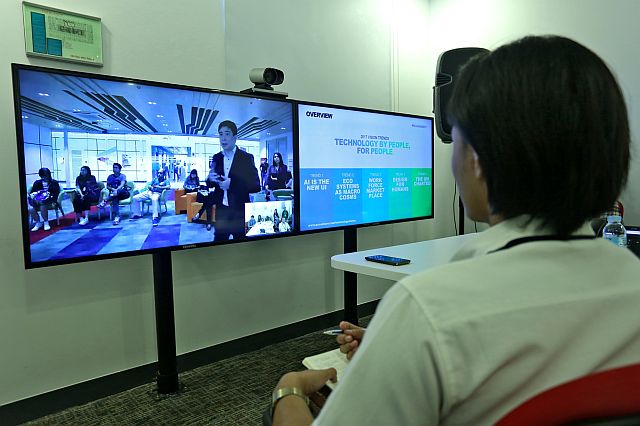
VIDEO CONFERENCE ON TECH VISION. JP Palpallatoc, Accenture PH digital lead, discusses his company’s technology vision for 2017 in a video conference with Cebu’s business reporters held at Accenture’s office in I.T. Park, Barangay Apas, Cebu City. (CDN PHOTO/JUNJIE MENDOZA)
As artificial intelligence (AI) moves to the forefront of business operations in the Philippines, the workforce needs to learn more complex skills to cushion the risk of losing jobs to automation.
JP Palpallatoc, Accenture Philippines digital lead, said that with the rise of AI comes the risk of employment reduction, especially among those with lower-level skills.
“We need to move those with lower-level skills up the value chain through education and helping them learn more complex skills,” he said in a video conference with Cebu-based reporters on Wednesday.
While AI has the potential to support humans in terms of business, through digital means of transacting and interacting with customers, Palpallatoc also recognized that this technology runs the risk of displacing human workers.
With the many improvements to AI technology today, more companies have opted not to hire additional employees to handle transactions that can easily be automated such as responding to common customer queries.
The Philippine Information Technology-Business Process Management (IT-BPM) Roadmap 2022 has projected a decline in demand for low-level skilled workers in the coming years, but also sees a rise in need for workers with mid- to high-complexity skills.
Palpallatoc said the roadmap also focuses on education and getting the workforce ready once this time comes, putting an emphasis on developing graduates in Science, Technology, Engineering, and Math (STEM).
The industry roadmap targets to directly employ 1.8 million IT-BPM workers by year 2022, of which 73 percent hold mid- to high-value jobs.
But Palpallatoc said the opportunities in taking advantage of AI are greater than its risks, adding that the technology is among the five trends seen to drive the transformation of businesses in the next three years.
Citing Accenture’s Technology Vision 2017, Palpallatoc said people used to be the ones adapting to technology but are now starting to make technology adapt to them and their needs.
The report identified five emerging technology trends that are essential to business success in today’s digital economy, based on insight from more than 5,400 business and IT executives surveyed worldwide.
Among these are AI becoming the new User Interface (UI), underpinning the way transactions and interaction are done with systems.
According to the report, 79 percent of executives agreed that AI will revolutionize the way they gain information from and interact with customers.
Meanwhile, 85 percent reported that they will invest intensively in AI-related technologies over the next three years.
Another trend was “design for humans,” where technology decisions are being made by humans for humans.
Technology now adapts to how people behave, which many executives believe should be used to guide a business’s desired outcomes.
The report also saw a surge in demand for labor platforms and online work-management solutions, resulting to companies dissolving traditional hierarchies and replacing them with talent marketplaces.
Case in point, 85 percent of executives surveyed said they plan to increase their organization’s use of independent freelance workers over the next year.
Another trend seen by Accenture was “ecosystems as macrocosms,” where platform companies that provide a single point of access to multiple services have completely broken rules on how companies compete.
Companies are now integrating their core business functionalities with third parties and leverage these relationships to build their roles in new digital ecosystems.
One example is car manufacturing company General Motors (GM) investing $500 million on ride-hailing app Lyft, launching a program that allows car-less drivers of Lyft to “rent” vehicles made by GM, opening up an entirely new line of business.
Accenture’s annual report also stated that to succeed in today’s ecosystem-driven digital economy, businesses must delve into unchartered territory.
Instead of focusing on the introduction of new products and services, firms should also seize opportunities to establish rules and standards for entirely new industries. /with USJ-R Intern Vanisa Soriano

